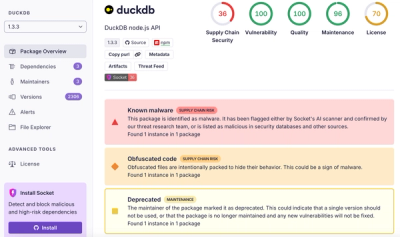
Product
Introducing Tier 1 Reachability: Precision CVE Triage for Enterprise Teams
Socket’s new Tier 1 Reachability filters out up to 80% of irrelevant CVEs, so security teams can focus on the vulnerabilities that matter.
a fake redis for node.js
This module provides easy-to-use simulated instances of Redis to which you appear to be connected via the redis client by Matt Ranney. It helps with writing tests in two ways: your tests won't require an actual redis instance and you'll be able to safely run as many tests in parallel as you want.
Install:
npm install fakeredis
You can use fakeredis as you would use node_redis,
just changing the module name from redis to fakeredis:
var client = require("fakeredis").createClient(port, host);
Both parameters are optional, and only serve to determine if you want to reuse a an existing fakeredis instance or not. You can also just name your backends arbitrarily:
// Create a connection to a fresh fakeredis instance:
var client = fakeredis.createClient("social stuff");
// Connect to the same backend via another simulated connection:
var concurrentClient = fakeredis.createClient("social stuff");
By omitting both parameters, you simply create a new blank slate fakeredis instance:
var client = require("fakeredis").createClient();
In other words,
every time you create a client specifying the same port and/or name
you reuse the same simulated backend.
This makes most sense when you need a concurrent client setup for some test,
say because you need to publish / subscribe,
or because you want to test something that's based on MULTI/EXEC
and uses optimistic locking with WATCH/UNWATCH.
In any case, fakeredis is great for testing because you can run as many tests in parallel as you wish, and that's also why you'll generally be naming your clients in a way that ensures tests don't collide.
By default fakeredis simulates network latency to help you discover race-conditions when testing multi-client setups. Network latency can be disabled using the .fast option:
var client = require("fakeredis").createClient(port, host, {
fast : true
});
One key difference is that the output of some commands,
such as SMEMBERS, HKEYS, HVALS,
comes out sorted lexicographically to provide for simpler testing.
This means that some tests that make use of undocumented Redis behaviours
such as the chronological order of retrieval for members in a set
may fail when attempted with fakeredis.
To solve this,
whenever there is no documented sort order for a given Redis command's multi-bulk reply,
sort the output before asserting equality to ensure your tests run everywhere.
Another major difference is that commands that accept modifier parameters, such as
SORT key [BY pattern] [LIMIT offset count] [GET pattern [GET pattern ...]] [ASC|DESC] [ALPHA] [STORE destination]
currently only accept these parameters in the order that is stated in the documentation.
For example,
in Redis it appears to be perfectly legitimate to have SORT myset ALPHA LIMIT 0 5,
but in fakeredis this will currently return a syntax error.
I'm totally open to discussion on both points.
Fakeredis is still mostly stuck in the Redis 2.4 era.
All Redis 2.4 string, list, hash, set and sorted set commands, most keyspace commands, and some connection and server commands. Pubsub, transactions with optimistic locking are also fully implemented.
List of available commands:
Keyspace:
DBSIZE
EXISTS
EXPIRE
EXPIREAT
FLUSHDB
KEYS
PERSIST
DEL
RANDOMKEY
RENAME
RENAMENX
SORT
TTL
TYPE
Strings:
APPEND
BITCOUNT
DECR
DECRBY
GET
GETBIT
GETRANGE
GETSET
INCR
INCRBY
MGET
MSET
MSETNX
SET
SETBIT
SETEX
SETNX
SETRANGE
Hashes:
HDEL
HEXISTS
HGET
HGETALL
HINCRBY
HKEYS
HLEN
HMGET
HMSET
HSET
HSETNX
HVALS
Lists:
BLPOP
BRPOP
BRPOPLPUSH
LINDEX
LINSERT
LLEN
LPOP
LPUSH
LPUSHX
LRANGE
LREM
LSET
LTRIM
RPOP
RPOPLPUSH
RPUSH
RPUSHX
Sets:
SADD
SCARD
SDIFF
SDIFFSTORE
SINTER
SINTERSTORE
SISMEMBER
SMEMBERS
SMOVE
SPOP
SRANDMEMBER
SREM
STRLEN
SUNION
SUNIONSTORE
Sorted Sets:
ZADD
ZCARD
ZCOUNT
ZINCRBY
ZINTERSTORE
ZRANGE
ZRANGEBYSCORE
ZRANK
ZREM
ZREMRANGEBYRANK
ZREMRANGEBYSCORE
ZREVRANGE
ZREVRANGEBYSCORE
ZREVRANK
ZSCORE
ZUNIONSTORE
Pub/Sub:
PSUBSCRIBE
PUBLISH
PUNSUBSCRIBE
SUBSCRIBE
UNSUBSCRIBE
Transactions:
DISCARD
EXEC
MULTI
UNWATCH
WATCH
Connection and Server:
ECHO
PING
QUIT
SELECT
These do nothing but return OK:
AUTH
BGREWRITEAOF
BGSAVE
SAVE
Most notably, there's no support for Lua scripting and MONITOR is still missing.
None of the ready, connect, error, end, drain and idle
client events are currently implemented.
List of missing commands (will throw upon attempt to use):
Connection and Server:
CONFIG GET
CONFIG SET
CONFIG RESETSTAT
DEBUG OBJECT
DEBUG SEGFAULT
FLUSHALL
INFO
LASTSAVE
MONITOR
MOVE
OBJECT
SHUTDOWN
SLAVEOF
SYNC
MIT.
FAQs
Fake redis for testing, works as a drop-in replacement for node_redis
We found that fakeredis demonstrated a not healthy version release cadence and project activity because the last version was released a year ago. It has 1 open source maintainer collaborating on the project.
Did you know?

Socket for GitHub automatically highlights issues in each pull request and monitors the health of all your open source dependencies. Discover the contents of your packages and block harmful activity before you install or update your dependencies.

Product
Socket’s new Tier 1 Reachability filters out up to 80% of irrelevant CVEs, so security teams can focus on the vulnerabilities that matter.

Research
/Security News
Ongoing npm supply chain attack spreads to DuckDB: multiple packages compromised with the same wallet-drainer malware.

Security News
The MCP Steering Committee has launched the official MCP Registry in preview, a central hub for discovering and publishing MCP servers.